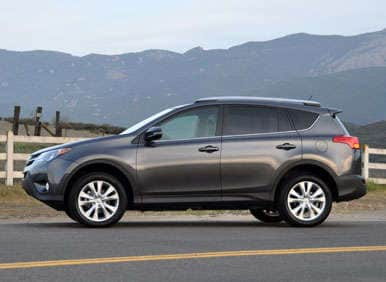Recent Articles
Popular Makes
Body Types
2013 Toyota RAV4 Road Test and Review
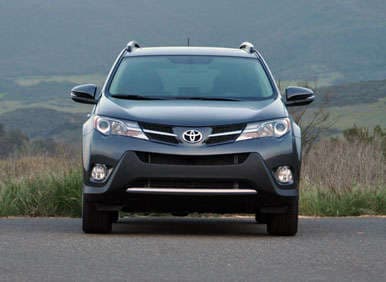
The 2013 Toyota RAV4 is redesigned for the first time since 2006, and for the fourth time since the automaker created the crossover SUV class with the original 1996 RAV4*. What’s new? In addition to a complete redesign inside, outside, and underneath, the 2013 RAV4 is equipped with a more fuel-efficient powertrain, driving modes that calibrate the powertrain to one of three settings, a roomier interior, and new safety technologies. The RAV4 also offers a more sophisticated optional all-wheel-drive system this year.
What’s gone? The optional 3.5-liter V-6 engine, which provided a whole bunch of extra horsepower and torque in exchange for a small penalty at the gas pump, is history. Toyota has canceled the Sport model, too, which looked good and handled better. The spare tire is moved from the RAV4’s tailgate, which facilitates inclusion of a top-hinged rear liftgate. Finally, the third-row seat option is dropped this year, which is unlikely to make anyone unhappy as it offered enough room only for children, who would whine loudly and continually about their utter lack of outward visibility.
We borrowed a 2013 Toyota RAV4 Limited with front-wheel drive to find out whether the new RAV4 has what it takes to compete against heavy-hitters like the Chevrolet Equinox, Ford Escape, Honda CR-V, Hyundai Tucson, Kia Sportage, Mazda CX-5, Nissan Rogue, Subaru Forester, and Volkswagen Tiguan. After a week of schlepping a family of four all around metropolitan Los Angeles, this long-time RAV4 fan finds the new version of the SUV less satisfying than expected.
* The original RAV4 debuted the same year that the Subaru Legacy Outback added a raised suspension and oversize fog lights, and the two models are widely credited as the first modern crossover SUVs.
2013 Toyota RAV4 Road Test and Review: Models and Prices
Toyota offers the 2013 RAV4 in three trim levels equipped with front- or all-wheel drive. The RAV4 LE is the base model ($24,145), the RAV4 XLE is the mid-grade model ($25,135), and the RAV4 Limited is the best-equipped model ($27,855). All prices include a delivery fee of $845.
Standard equipment includes air conditioning, power exterior mirrors, power windows, power door locks, remote keyless entry, dark tinted rear privacy glass, cruise control, and a tilt/telescopic steering wheel. The RAV4 LE is also equipped with a standard Display Audio system with a 6.1-inch touchscreen display, Bluetooth connectivity, and a reversing camera system.
Move up to the RAV4 XLE, and this cute-ute comes with 17-inch aluminum wheels, fog lights, roof rails, heated outside mirrors with turn signal indicators, and a power sunroof. Inside, the XLE model adds a dual-zone automatic climate control system, sport-bolstered front seats, a height-adjustable driver’s seat, and a cargo cover.
The RAV4 Limited is equipped with 18-inch aluminum wheels, automatic projector-beam headlights, and a Smart Key passive entry and push-button ignition system. The Limited model’s seats are wrapped in SofTex synthetic leather, while the steering wheel has a genuine leather wrap along with audio and Bluetooth controls. Heated front seats, an 8-way power driver’s seat with memory, and a height adjustable power rear liftgate are also standard on this model.
To the RAV4 Limited’s standard equipment, my test vehicle included an option package containing a navigation system, a JBL premium audio system, satellite radio, a Blind Spot Monitor system, and Rear Cross-Traffic Alert technology. The price came to $30,015.

2013 Toyota RAV4 Road Test and Review: Design
- Redesigned with corporate Toyota mustachioed “face”
- Top-hinged rear liftgate replaces side-hinged rear tailgate
- Spare tire moved to a new location under cargo floor
- New interior design with more rear-seat and cargo room
Let me get something off of my chest right off the bat: I’m no fan of the RAV4’s new styling. I prefer the previous-generation model, and the one that came before that. To my eyes, many modern Toyotas look like they’re angry, scowling while wearing chrome moustaches. That includes the new RAV4, and because crossover SUVs must look as rugged as possible, this one appears to have a serious under-bite. With fangs. And braces.
Around back, the 2013 RAV4 is cleaner looking thanks to the relocation of the spare tire from the back of the vehicle, where it was really easy to access for tire changes even with a full load of luggage, to a new spot under the cargo floor, where it is not. The benefit of this change, however, is that the side-hinged tailgate from the old model is replaced with a top-hinged liftgate. On Limited models, the liftgate is power operated, and takes what feels like forever to open and close.
The dominant rear styling elements are large, bulging, horizontally oriented taillights. Whenever I glance at a new RAV4, I am instantly reminded of a Buick Rendezvous or a GMC Terrain. Your results are likely to vary.
In contrast to the RAV4’s exterior, I really like the new interior. Though still constructed with a preponderance of hard plastics, the interior’s architectural design elements, soft-touch dashboard accent, padded center and door panel armrests, cloth headliner material, and carbon-fiber-patterned trim create a cabin that looks far more upscale than the previous RAV4. It still isn’t perfect, but it sure is better.
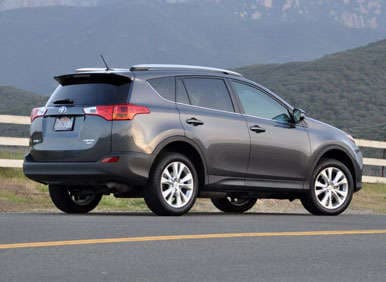
2013 Toyota RAV4 Road Test and Review: Comfort and Cargo
- Additional rear seat room
- Slightly larger cargo space
- Top-hinged liftgate replaces side-hinged tailgate
- SofTex synthetic leather for Limited models
- Power liftgate with adjustable height for Limited models
On my last day with the RAV4, it was sunny and 72 degrees in Los Angeles. The SUV was parked in the sun, with the sunroof cover open. When I got in and started the engine, the automatic climate control immediately began attempting to cool the cabin. Unfortunately, it blew copious amounts of hot air for the first mile of travel, changing to warm air for a bit, and then finally cool air as I sweated profusely on the SofTex synthetic leather upholstery. In fairness, I must share with you that my test car was a pre-production vehicle, and this delayed response by the air conditioning system could, possibly, be explained by such status.
Aside from this, the RAV4 offers a comfortable driver’s seat facing an appealing, thick-rimmed, small-diameter, tilt/telescopic steering wheel with thumb rests. The center console armrest slides forward for additional comfort, and the driver enjoys an excellent view out.
The rear seat provides generous leg and foot room, but the bottom cushion is rather low in order to provide a flat cargo floor when the seatbacks are folded down. Doing so requires removal of the rear seat headrests, but they are easy to pop off and store on the floor.
With the rear seat folded down, the RAV4 supplies 73.4 cu.-ft. of cargo space, a substantial amount for a compact SUV, and a larger amount of volume than some midsize suvs. Similarly, the RAV4’s 38.4 cu.-ft. space behind the rear seat is impressive for the class. Hauling stuff is not a problem for a RAV4. Waiting for the Limited model’s power liftgate to open and close at its glacial pace is a problem. But at least the RAV4 is no longer saddled with a heavy cargo door that swings open toward the curb, negating its usefulness in many parking situations.
The RAV4 offers plenty of storage space up front, too. The glove box is enormous, and the center console storage bin is a useful size. The dashboard is equipped with shelf with a rubber liner to hold items in place. Another storage tray in the center console lacks a rubber liner, and does not hold items in place.
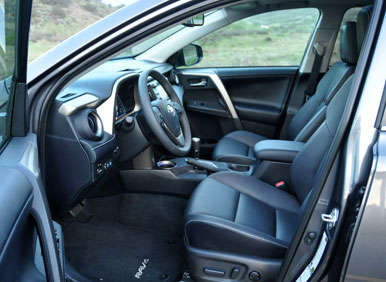
2013 Toyota RAV4 Road Test and Review: Features and Controls
- Clear Blue nighttime gauge illumination
- Standard Display Audio system with 6.1-inch touchscreen
- Standard reversing camera system
- Optional Smart Key passive entry and push-button starting
Toyota uses a common components bin to outfit its vehicles, and it’s a good one filled with refined controls marked in clear lettering and symbols. Anyone can get into a 2013 RAV4 and instantly understand how everything works, especially if they’re already familiar with other Toyota products.
The only exception might be the RAV4’s standard Display Audio system. Since the new RAV4 was designed to use this technology, the version installed in this model is cleanly integrated into the dashboard, surrounded by large buttons and knobs with big, legible labels. The touchscreen itself, however, is susceptible to glare and I frequently find it unresponsive to touch commands that aren’t executed with laser accuracy.
Aside from occasionally finicky Display Audio virtual buttons, the only ergonomic challenge presented by the RAV4’s cabin pertains to the controls that active the Eco and Sport driving modes, and which manage the optional all-wheel-drive system. They’re tucked down low at the bottom of the center stack of controls, and are both hard to see and reach.
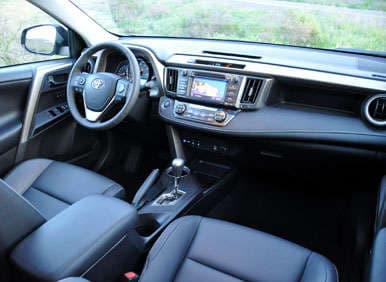
2013 Toyota RAV4 Road Test and Review: Safety and Ratings
- Eight standard airbags
- Standard reversing camera
- Optional Blind Spot Monitor system
- Optional Rear Cross-Traffic Alert system
The redesigned 2013 RAV4 is equipped with eight airbags, traction and stability control, and 4-wheel-disc anti-lock brakes with brake assist. Standard Smart Stop technology is designed to prevent the SUV’s ability to accelerate if the brake pedal is pressed, and a reversing camera system is installed for every RAV4 this year. New safety-related options include a Blind Spot Monitor and a Rear Cross-Traffic Alert system.
Though the RAV4 arrived in showrooms late, following its introduction at the Los Angeles Auto Show in November of last year, it is nevertheless a top-selling model in a popular class of vehicles. Yet the National Highway Traffic Safety Administration and the Insurance Institute for Highway Safety have not performed crash tests on the 2013 RAV4 as of the end of March, when this review was published.
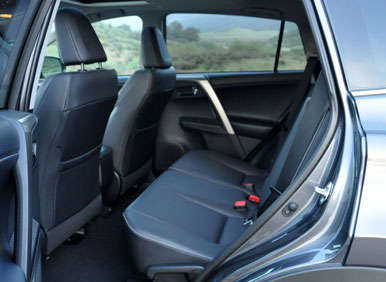
2013 Toyota RAV4 Road Test and Review: Engines and Fuel Economy
- 6-speed automatic transmission
- Eco, Normal, and Sport driving modes
- Dynamic Torque Control AWD system
- Electric steering
Equipped with a 2.5-liter 4-cylinder engine that carries over from last year with minor changes, the 2013 RAV4 makes three fewer horsepower than before, rated to generate 176 horsepower at 6,000 rpm and 172 lb.-ft. of torque at 4,000 rpm. Unlike last year, a more powerful V-6 engine option is no longer available.
Down slightly in terms of horsepower and up slightly in terms of base curb weight, the 2013 RAV4 is nevertheless more fuel-efficient thanks to its new 6-speed automatic transmission and electric steering. Previously, the RAV4 with the 4-cylinder engine and front-wheel drive was expected to get 22 mpg in the city, 28 mpg on the highway, and 24 mpg in combined driving. The new 2013 RAV4’s EPA ratings are 24 mpg in the city, 31 mpg on the highway, and 26 mpg in combined driving.
Based on my experience, it appears the RAV4’s mileage estimates are overstated. I averaged 22.1 mpg, with more than half the miles driven spent on L.A. freeways, and almost all of the miles traveled with the powertrain in Normal mode. That’s far short of the expected 26 mpg for my test vehicle, and less than the 22.7-mpg average I achieved in a 2012 RAV4 with this engine. Perhaps I should have spent more time driving with the Eco mode engaged.
What my test sample lacked was the RAV4’s new Dynamic Torque Control all-wheel-drive system. With this system, the driver selects between Auto, Lock, and Sport modes. The first two are fairly self-explanatory. In Auto mode, power transfers to the rear wheels when the front wheels slip. In Lock mode, power is evenly split between the front and rear wheels, but only at speeds up to 25 mph.
If the driver chooses the powertrain’s Sport mode, the RAV4 is designed to deliver crisper throttle response, to hold gears longer and shift faster, and quicken the electric steering while giving it a heavier feel. With Dynamic Torque Control AWD, this driving mode also provides a torque vectoring effect based on yaw rate and steering angle.
Maybe I would have found the new RAV4 more fun to drive had my test vehicle been thusly equipped.
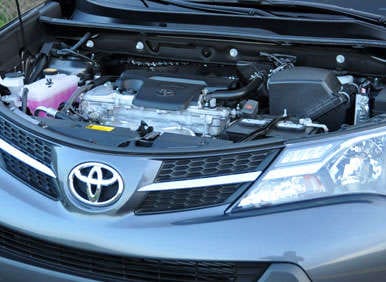
2013 Toyota RAV4 Road Test and Review: Driving Impressions
In reviewing my notes from a test drive of a 2012 RAV4 with a 4-cylinder engine, I find myself griping about similar dynamic shortcomings in the new 2013 RAV4. The body rolls a little too much in higher speed turns and curves, the tires lack grip and offer low handling limits, and the engine feels lifeless when the driver makes a decisive demand for extra power. Last year I characterized the RAV4 as “calibrated for the vast majority of drivers seeking Point A to Point B transportation with a minimum of hassle.” This year, I can’t even say that.
Here’s why. The RAV4 Limited I drove, perhaps because of its 18-inch wheels and P235/55 all-season tires, delivered an often choppy and occasionally harsh ride quality, something that might be acceptable to a buyer choosing a Sport Package but only in exchange for improved handling. With the 2013 RAV4, that doesn’t seem to be the case. Though the SUV feels nimble and athletic in low-speed, urban driving situations, it ultimately delivers modest handling and grip on a curvy country road. In the city, the shock associated with traversing potholes, pavement heaves, and recessed manhole covers is transmitted directly to the cabin.
This is one reason the new RAV4 doesn’t feel as fun to drive as the old RAV4. Another is that the 4-cylinder engine just doesn’t feel as energetic as it used to, the 6-speed transmission occasionally confused about whether it ought to be upshifting, downshifting, or holding a gear. Apply part-throttle commands at the accelerator pedal, and the transmission responds decisively. Apply full-throttle commands at the accelerator pedal, and it responds haltingly. Perhaps I should have spent more time driving with the Sport mode engaged.
Fortunately, Toyota provides a handy manual shift gate to the left of the main selector path, snug to the driver’s right leg and intuitive in operation. Move the shifter up to upshift, and down to downshift. Using the manual gate does make driving the new RAV4 more gratifying.
Though the RAV4’s driving dynamics, for the most part, appear to require additional refinement, I found it really easy to exceed the speed limit on the freeway. The connected suspension, the decently tuned electric steering, and the excellent outward visibility somehow mask the sensation of speed, and I frequently found myself driving above what might considered the average speed of the flow of traffic.
Good thing, then, that Toyota really nailed the brake pedal calibration. Not only is the pedal easy to modulate, allowing the driver to bleed onto and off of the brakes with ease, grace, and precision, but when abused repeatedly on mountain grades, they never faded.
If Toyota can apply the same attention to detail it bestowed upon the RAV4’s brakes to the rest of the SUV’s dynamic tuning, add a turbocharged 4-cylinder engine option, and either install some stickier tires or re-tune the suspension for better ride isolation, it will have resolved several of these issues.
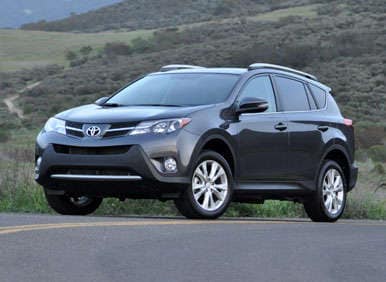
2013 Toyota RAV4 Road Test and Review: Final Thoughts
Historically, each successive RAV4 redesign has provided compact crossover SUV buyers with a dramatically improved vehicle, one displaying instantly evident benefits compared to the previous version. This time around, that’s not necessarily the case.
Practically speaking, the new RAV4 is about the same size as the old one, and gets about the same fuel economy based on my testing. The exterior is less appealing to my eye, but the interior is more attractive. New safety technologies and, depending on crash-test results, likely structural improvements make the new RAV4 safer than ever before. So yes, the new RAV4 is better in some respects.
The problem is that in other respects, it’s not better. I miss the old RAV4 already.
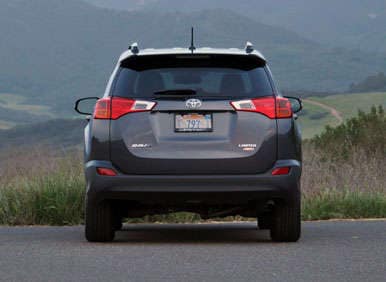
2013 Toyota RAV4 Road Test and Review: Pros and Cons
- Standard Bluetooth connectivity
- Standard reversing camera system
- Practical and appealing interior
- Roomy seats, especially in back
- Large cargo carrying capacity
- Top-hinged liftgate design
- New safety technologies
- Excellent driving position
- Air conditioning is full of hot air
- Disappointing fuel economy
- Lackluster driving dynamics
- Firm, regularly harsh, ride quality
- Slow operation of power liftgate
- V-6 engine option is canceled
Toyota supplied the vehicle for this review
2013 Toyota RAV4 Limited photos by Christian Wardlaw
